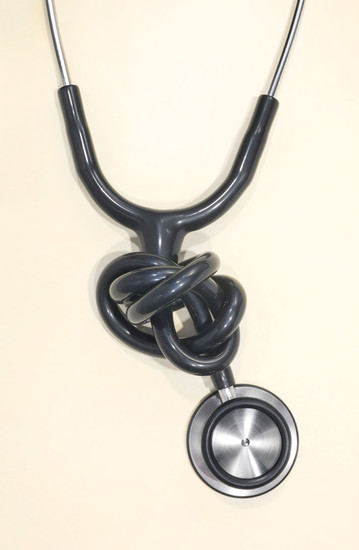Such devastating errors lead to permanent damage or death for as many as 160,000 patients each year, according to researchers at Johns Hopkins University. Not only are diagnostic problems more common than other medical mistakes—and more likely to harm patients—but they’re also the leading cause of malpractice claims, accounting for 35% of nearly $39 billion in payouts in the U.S. from 1986 to 2010, measured in 2011 dollars, according to Johns Hopkins.
The good news is that diagnostic errors are more likely to be preventable than other medical mistakes. And now health-care providers are turning to a number of innovative strategies to fix the complex web of errors, biases and oversights that stymie the quest for the right diagnosis.
Part of the solution is automation—using computers to sift through medical records to look for potential bad calls, or to prompt doctors to follow up on red-flag test results. Another component is devices and tests that help doctors identify diseases and conditions more accurately, and online services that give doctors suggestions when they aren’t sure what they’re dealing with.
Finally, there’s a push to change the very culture of medicine. Doctors are being trained not to latch onto one diagnosis and stick with it no matter what. Instead, they’re being taught to keep an open mind when confronted with conflicting evidence and opinion.
“Diagnostic error is probably the biggest patient-safety issue we face in health care, and it is finally getting on the radar of the patient quality and safety movement,” says Mark Graber, a longtime Veterans Administration physician and a fellow at the nonprofit research group RTI International.
Big Efforts Under Way
The effort will get a big boost under the new health-care law, which requires multiple providers to coordinate care—and help prevent key information like test results from slipping through the cracks and make sure that patients follow through with referrals to specialists.
There are other large-scale efforts in the works. The Institute of Medicine, a federal advisory body, has agreed to undertake a $1 million study of the impact of diagnostic errors on health care in the U.S.
In addition, the Society to Improve Diagnosis in Medicine, which Dr. Graber founded two years ago, is working with health-care accreditation groups and safety organizations to develop methods to identify and measure diagnostic errors, which often aren’t revealed unless there is a lawsuit. In addition, it’s developing a medical-school curriculum to help trainees improve diagnostic skills and assess their competency.
Robert Wachter, associate chairman of the department of medicine at the University of California, San Francisco, says defining and measuring diagnostic errors is an important step. “Right now, none of the incentives for improvement in health care are based on whether the doctor made the correct diagnosis,” Dr. Wachter says. But equally important, he adds, “we need to nurture bottom-up innovation.”
That’s already happening. Large health-care systems are mining their electronic records for missed signals. At the Southern California Permanente Medical Group, part of managed-care giant Kaiser Permanente, a “Safety Net” program periodically surveys its database of 3.6 million members to catch lab results and other data that might fall through the cracks.
In one of the first uses of the system, a case manager reviewed 8,076 patients with abnormal PSA test results for prostate cancer, and more than 2,200 patients had follow-up biopsies. From 2006 to 2009, 745 cancers were diagnosed among those patients—and Kaiser had no malpractice claims related to missed PSA tests.
The program is also being used to find patients with undiagnosed kidney disease, which is often found via an abnormal test result for creatinine, which should be repeated within 90 days. From 2007 to 2012, the system found 7,218 lab orders placed for patients with an abnormal test that had not been repeated. Of those, 3,465 were repeated within 90 days of a notice to patients that they needed a repeat test, and 1,768 showed abnormal results. The majority, 1,624, turned out to be new cases of the disease.
Michael Kanter, regional medical director of quality and clinical analysis, says the system enables clinicians to go back “as far as is feasible to find all of the errors that we can and fix them.”
Because the disease is slow moving, Dr. Kanter says, people with a five-year-old undiagnosed case may not have been harmed. Likewise, with many early prostate cancers, “in many of these cases it doesn’t mean harm would have reached the patient,” he says. “But we don’t want patients not to have the information they should have had through some kind of lapse in the system.”
Dealing With the Flood
Electronic records aren’t a panacea, of course, and can even lead to information overload. In a survey of Veterans Administration primary-care practitioners reported last March in JAMA Internal Medicine, more than two-thirds reported receiving more patient-care-related alerts than they could effectively manage—making it possible for them to miss abnormal test results.
Some researchers suggest the best solution isn’t to flood doctors with information but to provide a second set of eyes to find things they may have missed.
The focus now is preventing dangerous delays in follow-ups of abnormal test results. In a pilot program, researchers at the Houston VA developed “trigger” queries—a set of rules—to electronically identify medical records of patients with potential delays in prostate and colorectal cancer evaluation and diagnosis. Records included charts that had no documented follow-up for abnormal findings suspicious for cancer after a certain period, according to the research team’s leader, Hardeep Singh, chief of health policy and quality at Michael E. DeBakey VA Medical Center in Houston and an assistant professor of medicine at Baylor College of Medicine.
The queries were run on nearly 600,000 records of patients seen at one VA facility in 2009 and 2010. Dr. Singh says the use of triggers, which helped find abnormal PSA tests and positive fecal occult blood tests, could detect an estimated 1,048 instances of delayed or missed follow-up of abnormal findings annually and 47 high-grade cancers.
The VA has funded a randomized trial to test whether an automated surveillance system of triggers can improve timely diagnosis and follow-up for five common cancers.
“This program is like finding needles in a haystack, and we use information technology to make the haystack smaller and smaller so it’s easier to find the needles,” Dr. Singh says.
More health-care systems are also turning to electronic decision-support programs that help doctors rank possible diagnoses by likelihood based on symptoms and notes in the medical record. In a study of one such system, called Isabel, researchers led by Dr. Graber found that it provided the correct diagnosis 96% of the time when key clinical features from 50 challenging cases reported in the New England Journal of Medicine were entered into the system. The American Board of Internal Medicine is studying how Isabel could be linked to assessments of physician skill and knowledge.
Another system, DXplain, developed at Massachusetts General Hospital in Boston, was shown in a study last year to significantly improve diagnostic accuracy among first-year medical residents.
Edward Hoffer, associate clinical professor at Harvard and senior computer scientist at Mass General who leads the DXplain program, says the aim now is to have DXplain “push” diagnostic suggestions to physicians through an electronic-medical-records system rather than requiring doctors to initiate a query, which some are still reluctant to do. “We have to focus our attention on dealing with situations where doctors think they know what the diagnosis is, but they don’t,” Dr. Hoffer says.
Other Avenues
New devices also hold promise for confirming a diagnosis and avoiding unnecessary tests. A number of companies are rushing to provide aids such as portable diagnostic equipment and lab tests that can analyze tiny samples of blood and other bodily fluids quickly to detect disease.
Consider MelaFind, which came to market in the U.S. in 2011. The device allows dermatologists to noninvasively examine moles as deep as 2.5 millimeters beneath the surface to gauge the level of “disorganization,” an indicator of irregular growth patterns that are a sign of melanoma, among the deadliest cancers.
New York dermatologist Macrene Alexiades-Armenakas says she uses MelaFind to confirm that a mole is to be removed and prioritize the level of disorganization in multiple abnormal moles. In some cases, when another doctor or the patient has been concerned about a mole, MelaFind supported “clinical diagnosis of a benign mole, thereby sparing them a biopsy,” she says.
But such devices will never replace a thorough physical exam with a trained eye and careful follow-up, says Dr. Alexiades-Armenakas: “These diagnostic tools are aids to increase our accuracy and adjuncts to good physical diagnosis, not a substitute.”
Some efforts to cut down on errors take a different route altogether—and try to improve diagnoses by improving communication.
For instance, there’s a push to get patients more engaged in the diagnostic process, by encouraging them to speak up about their symptoms and ask the doctor, “What else could this be?” At Kaiser Permanente, a pilot program provides patients with a pamphlet that encourages them to think about and write down their symptoms and what concerns or fears they have, encouraging them to ask specific questions to be sure they understand their diagnosis and the next steps they must take.
Medical schools, meanwhile, are teaching doctors to be more receptive to patient input and avoid “anchoring,” the habit of focusing on one diagnosis and excluding other possible scenarios, and “premature closure,” not even considering the correct diagnosis as a possibility.
The Critical Thinking program at Dalhousie University in Halifax, Nova Scotia, established last year, aims to help trainees step back and examine how biases may affect their thinking. Developed by Pat Croskerry, a physician known for his research on the role of cognitive error in diagnosis, it uses a list of 50 different types of bias that may lead to diagnostic error.
The program is being integrated throughout four years of the medical school. Students study cases such as a psychiatric patient with shortness of breath who was assumed to be merely having an anxiety attack; doctors overlooked that she was a smoker on birth-control pills, a risk for the blood clot that later traveled to her lung and killed her.
“If we can teach physicians how to think more critically,” Dr. Croskerry says, “they would be more effective in delivering good care and arriving at the right diagnosis.”
Ms. Landro is an assistant managing editor for The Wall Street Journal and writes the paper’s Informed Patient column. She can be reached at laura.landro@wsj.com.










